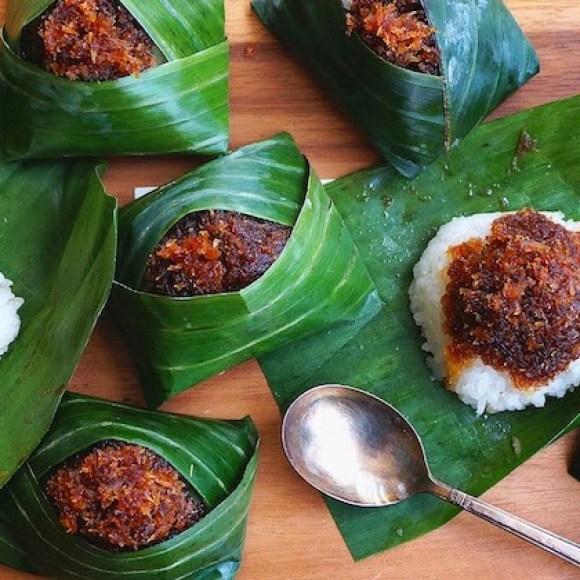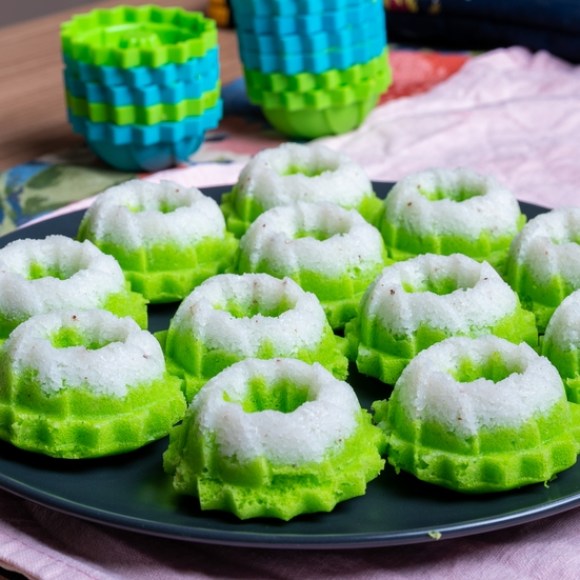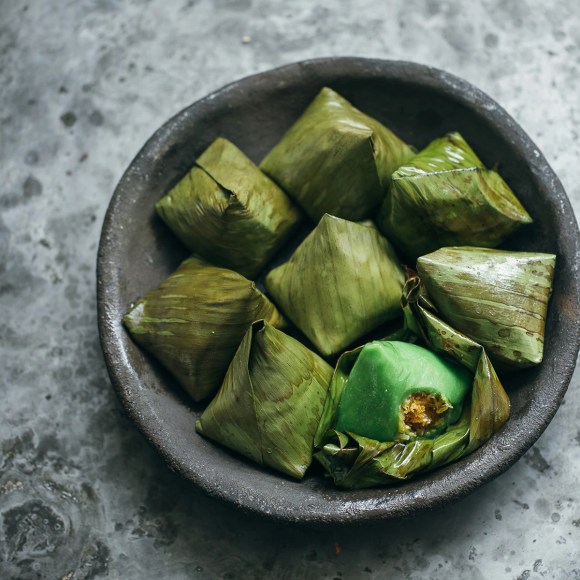Kuih is a Malay word used to describe bite-sized snacks such as cakes, biscuits, bread and even porridge. The term is used generically to mean Malay desserts.
With a diverse culture in Malaysia, the kuihs comes in many different shapes, sizes, textures, colours and taste. Although it is usually eaten for breakfast or as snacks, kuih is a type of delicacy that can be eaten at anytime. Traditional kuih in Malaysia is enjoyed by all Malaysians, and it is rarely heard that people dislike it.
And if you wonder what kind of kuih do we have, here’s the ultimate guide to Malaysian kuih-muih for you to feast your eyes on!
Kuih Lapis

Also known as ‘nine-layer cake’, the kuih lapis is easily identified by its multi-coloured layers which can be easily separated and eaten individually. It can be made in many different combinations, but the traditional combination is red, orange and white.
Pulut Tai-tai

Pulut tai-tai is one of the most popular and classic nyonya pastry. This elegant kuih is a glutinous rice cake that’s marbled with a bunga telang (butterfly pea flower) blue and is served with a local made kaya.
Kuih Talam

A classic kuih which is a favourite of many Malaysians. The green bottom layer is made of rice and mung bean flour, flavoured with pandan; while the white upper layer is made of lightly salted creamy coconut milk. Sometimes the bottom layer can also be made with yellow yam or brown coconut sugar, but the most common is with the green pandan.
Seri Muka

The seri muka is often mistaken for kuih talam due to its colours, but only in the opposite layer. The top layer is usually made of green pandan and paired with the bottom layer made with glutinous rice. Sometimes the pulut may be cooked with bunga telang for a distinctive blue tint or steamed with pandan on its own.
Kuih Bingka Ubi

With its distinctive yellow tint and dark brown caramelised top, bingka ubi is also one of the most popular kuihs. The bingka ubi is made with finely grated tapioca and mixed with sugar, eggs, pandan and coconut milk before being baked. This chewy cake is semi-soft with a springy texture and a crispy crust on top.
Kuih Ketayap

The kuih ketayap which is also known as kuih dadar gulung is a Malay kuih that features shredded coconut and palm sugar wrapped in spongy pandan crêpe.
Ang Ku Kuih

A Chinese pastry, ang ku kuih is translated as “red tortoise” kuih. It is made in a small round or oval shaped sticky glutinous rice flour skin wrapped around a fragrant mung bean paste filling. The mold resembles tortoise and the skin made in red colour, and hence it is called the “ang ku”.
Pulut Inti

The pulut init is made of grated sweet coconut cooked with palm sugar, pandan and a bit of salt heaped onto glutinous rice (pulut) and then wrapped in banana leaf. In the recent times, more sellers opt for small plastic packaging as it it easily obtained compared to the traditional banana leaf.
Kuih Kosui

These bite-sized soft and chewy steamed Nyonya cakes is known as kuih lompag in the Malay community. This kuih is usually steamed in small ceramic tea cups that give it its shape. The kuih kosui comes in two different colours which represents two different flavours, the pandan and the gula Melaka. It is the served along with a topping of fresh grated coconut.
Kuih Bakar

Kuih bakar fundamentals include rich pandan and eggy flavours, as well as a nicely smoky, caramelised sesame seed-encrusted top. While it’s usually baked in the oven, it gets extra smokiness and char when cooked over an open fire.
Huat Kuih

Traditionally huat kuih, the cupcake-like pastry is used by the Chinese as an offering in prayers. Huat is referred to the cake’s rising process as well as meaning ‘prosperity’ in the Hokkien dialect. The huat kuih is made with a light pandan fragrance and an addictively fluffy texture when freshly steamed.
Pulut Panggang

The pulut panggang is a glutinous rice kuih commonly filled with meat floss, dried shrimps and sambal belacan. It is wrapped in cylindrical banana leaf bundles and grilled for an extra smoky factor.
Kuih Kacang Merah

A type of kuih talam, kuih kacang merah is made with red beans, coconut milk and pandan. Kacang merah is directly translated as red beands. Some versions have lightly salted red beans which gives it a different taste.
Puteri Ayu

This kuih of Malay-Indonesian origin comes in mini bundt-cake-like shapes. It is a fluffy bite-sized sponge cakes crowned with lightly salted fresh shredded coconut.
Kuih Sago Ubi

The kuih sago ubi is a tapioca pastry steamed with a generous top layer of sago pearls cooked in gula Melaka. It is then coated with freshly grated coconut.
Lepat Pisang

This traditional Malay kuih is one of the easiest local pastry to make. It is basically bananas mashed with flour, sugar and fresly grated coconut, then steamed in a banana leaf.
Pak Thong Ko

The subtly sweet pak thong ko, which means ‘white sugar sponge cake’ in Cantonese has delicious yeasty flavours derived from Chinese wine yeast. Due to the yeast and longish fermentation period, this kuih is noted for its honeycomb structure.
Tepung Pelita

A wobbly, white colour kuih, the tepung pelita is popular from the East Coast and made of pandan and coconut milk custard. It is steamed in a small banana leaf vessel.
Kuih Koci

Kuih koci is a type of dumpling made from glutinous rice flour, and stuffed with coconut fillings with palm sugar.
Onde-onde

Onde-onde is a snack of sweet rice cake balls filled with molten palm sugar and coated in grated coconut. You know it is perfectly made when the fillings explodes and melts in your mouth when you take a bite of the onde-onde.




